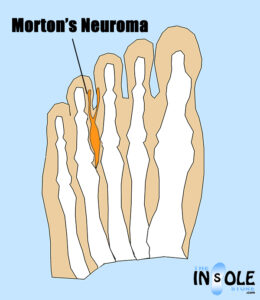Mortons Neuroma (also known as
Morton's Metatarsalgia or
Morton's disease) is a condition that occurs in the footmost often between the 3rd and 4th toeswhere the tissue thickens around the nerves leading to the toes. Frequent or constant pressure to this area of the foot will cause the formation of a benign tumor or what appears to be a hard ball under the skin.
Don't let the word tumor scare you. Although neuroma medically means "tumor," in this case it's more like a fibrous tissue formation rather than what is commonly known as a cancerous or malignant tumor. Common symptoms of Morton's Neuroma are numbness of the feet, burning & tingling between the toes, and/or shooting pains up the back of the leg.
Causes:
Morton's Neuroma is often caused by wearing tight-fitting shoes such as heels or other dress shoes, which place increased pressure on the foot and restrict the natural movement & expansion of the foot. Extensive compression of the nerves in the foot will trigger these symptoms.
Who is at risk?
Those who wear tight-fitting and narrow shoes often have a higher chance of developing Morton's Neuroma. Although this disease can affect both men and women, women between the age of 40 & 50 have a higher chance than men of developing this condition simply due to the fact they are more prone to wearing high heels. Dancers also have an increased risk of developing Morton's Neuroma due to the high amount of stress placed on their feet on a regular basis.
Diagnoses:
A doctor can diagnose you for Morton's Neuroma. A diagnosis will usually consist of evaluating your symptoms and checking for a ball-like structure near your toes with the use of an x-ray or ultrasound.
Treatment:
Morton's Neuroma can typically be treated by adding metatarsal cushions/pads, such as the
Spenco Gel Ball of Foot Cushions(1) or the
Pedag Feel Good Metatarsal Pads(2), to your footwear. Both of these options offer maximum levels of cushioning that will not slide around in your shoe and will provide shock absorption to comfort and protect the metatarsal area of your foot. For those who would instead prefer a full-length shoe insole that provides similar cushioning and support of the forefoot, then the
Powerstep Pinnacle Plus Orthotic Insoles(3) and the
Spenco Total Support Original Insoles(4) both feature built in metatarsal pads for targeted metatarsal pain relief. The most serious cases of Morton's Neuroma may require surgery and can take several weeks of recovery. Be sure to check out our
metatarsal insoles page for a full range of insole options featuring metatarsal cushion & support.
Prevention:
The best way to prevent Morton's Neuroma is to ensure that your shoes fit properly and allow your toes plenty of space to spread out. Shoes with a larger toe box are great for this because they are designed to give your toes plenty of space to flex. It is also important that you limit your use of high heels and/or perform nightly stretches to relieve any tension and stress in your toes & feet.
Morton's Neuroma can be extremely painful, but its not something that you have to suffer through. There are various shoe insole & insert options to prevent and treat the symptoms of the disease. For more treatment information about Morton's disease, visit
TheInsoleStore.com.

